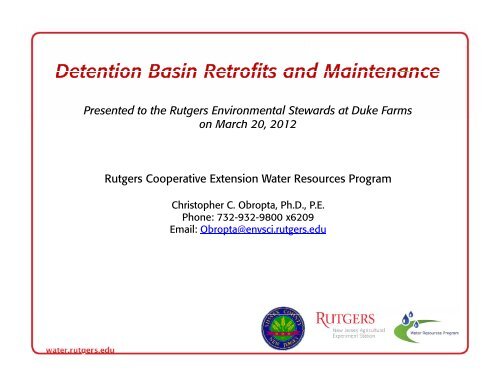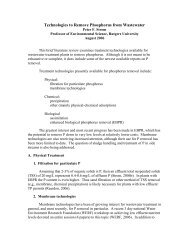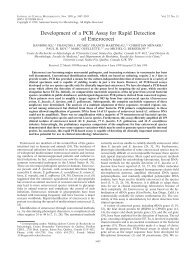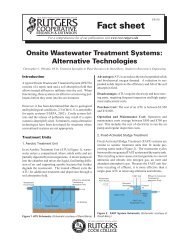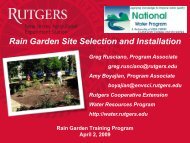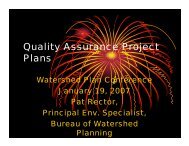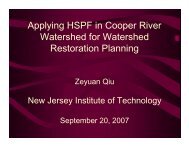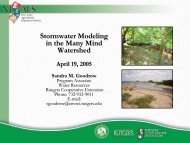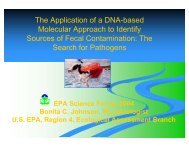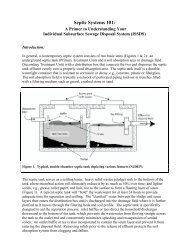Detention Basin Retrofits and Maintenance - Rutgers Cooperative ...
Detention Basin Retrofits and Maintenance - Rutgers Cooperative ...
Detention Basin Retrofits and Maintenance - Rutgers Cooperative ...
Create successful ePaper yourself
Turn your PDF publications into a flip-book with our unique Google optimized e-Paper software.
<strong>Detention</strong> <strong>Basin</strong> <strong>Retrofits</strong> <strong>and</strong> <strong>Maintenance</strong>Presented to the <strong>Rutgers</strong> Environmental Stewards at Duke Farmson March 20, 2012<strong>Rutgers</strong> <strong>Cooperative</strong> Extension Water Resources ProgramChristopher C. Obropta, Ph.D., P.E.Phone: 732-932-9800 9800 x6209Email: Obropta@envsci.rutgers.edu
1. Overview of various basin designs2. Common l<strong>and</strong>scaping <strong>and</strong> maintenance concerns3. <strong>Maintenance</strong> requirements4. Typical maintenance costs5. Ways to reduce maintenance6. Case Studies7. Planning for maintenance8. NJ BMP Manual – <strong>Maintenance</strong> Plan9. References
<strong>Basin</strong>s whose outlets have been designed to detain stormwater runofffor some minimum time to prevent downstream flooding. Providequantity control, mowed regularly with concrete low-flow channels,dry except during <strong>and</strong> immediately following a storm event (typically48 hours).<strong>Basin</strong>s can also treat stormwater runoff through settling of particles.
(a.k.a. a stormwater ponds, wet retention ponds, wet ponds)Retention basins are often used as l<strong>and</strong>scape amenities withpermanent pools of st<strong>and</strong>ing water, stormwater fills the basin duringrainfall events <strong>and</strong> discharges until permanent water surface elevationis reached.Ponds will treat incoming stormwater runoff by allowing particles tosettle <strong>and</strong> algae to take up nutrients.
Does the basin hold a permanent pool of water?NO – <strong>Detention</strong>YES – RetentionUSEPAUSEPA
INLET STRUCTURES
OUTLET STRUCTURE
CONCRETE LOW-FLOW CHANNEL
SIDE SLOPESIDE SLOPE
BASIN BOTTOM
INLET STRUCTURESSIDE SLOPEBASIN BOTTOMSIDE SLOPECONCRETE LOW-FLOW CHANNELOUTLET STRUCTURE
1. Embankment <strong>and</strong> outlet stabilization2. Sedimentation3. Outlet blockages4. Broken or clogged low-flow channels5. St<strong>and</strong>ing water or wet soils6. Floatables <strong>and</strong> debris7. Weeds or woody vegetation8. Mowing <strong>and</strong> l<strong>and</strong>scaping costs
Activity•Note erosion of pond banks or bottom•Inspect for damage to the embankment•Monitor i for sediment accumulation in the facility<strong>and</strong> forebay•Examine to ensure that inlet <strong>and</strong> outlet devicesare free of debris <strong>and</strong> operational•Repair undercut or eroded areas•Mow side slopes•Manage gpesticide <strong>and</strong> nutrients•Remove litter <strong>and</strong> debris•Seed or sod to restore dead or damaged groundcover•Remove sediment from the forebay•Monitor sediment accumulations, <strong>and</strong> removesediment when the pond volume has beenreduced by 25 percentScheduleSemiannual inspectionAnnualinspectionSt<strong>and</strong>ard maintenanceAnnual maintenance(as needed)5- to 7-yearmaintenance25- to 50-yearmaintenance
• Routine <strong>Maintenance</strong>– Vegetation ti managementrunoff.– Debris <strong>and</strong> litter removal– Mechanical components maintenance– Inspections• Non-Routine <strong>Maintenance</strong>– Stabilization <strong>and</strong> erosion control repairs– Sediment removal– Outlet repair or replacementProperly designed <strong>and</strong>maintained wet detentionbasins can remove 80% of thesuspended solids in urban
Routine <strong>Maintenance</strong>
• Vegetation management– Mowing should be done where/when it is needed (traditionally,10-14 times per year)– Effective groundcovers must be kept healthy to prevent erosion<strong>and</strong> damage to the system• Debris <strong>and</strong> litter removal– Inlets <strong>and</strong> outlets should be regularly cleared of debris <strong>and</strong> litterto prevent obstructions <strong>and</strong> reduced efficiency of the system• Mechanical components maintenance– All mechanical equipment, such as gates, valves, locks, or othercomponents must be kept in working order should an emergencyarise• Inspections– Regular inspections by designated personnel, owner, or operatorshould be made <strong>and</strong> clear records kept
• Approximately 3-5% ofconstruction cost for annualmaintenance of dry detentionbasin or wet detention pond• Mowing can cost between$100-$500 per visit• Intensive maintenanceincluding mowing, weedcontrol, fertilization, etc. canrange from$500-$3,500/acre annually
C = 12.4V0.760where:C = Construction, design, <strong>and</strong> permitting cost, <strong>and</strong>V = Volume needed d to control the 10-year storm (ft 3 ).Using this equation, typical construction costs are:$ 41,600 1 acre-foot pond$ 239,000 10 acre-foot pond$ 1,380,000 100 acre-foot pondSource: USEPASource: USEPAhttp://cfpub.epa.gov/npdes/stormwater/menuofbmps/
• Vegetation management– Reduce need for mowing– Eliminate any use of commercial fertilizers <strong>and</strong> pesticides instormwater management facilities• Debris <strong>and</strong> litter removal– Install simple low cost retrofits on catch basins near the dischargeto the detention system• Mechanical components maintenance– Regular inspections <strong>and</strong> immediate repairs will reduce need formajor replacements• Inspections– Clearly l identify appropriate personnel <strong>and</strong> have same individualid conduct inspections at regular intervals
Meadow Management• Reduce mowing frequency of the basin bottom <strong>and</strong>embankments to a single monthly mowing at a heightof 6-8 inches during the months of May throughSeptember
MEADOW AREAMANICURED EDGE
No mow zones• In wet pond systems, eliminating regular mowing of the shorelineedge for a minimum of 5-10 feet <strong>and</strong> allowing vegetation to growto a height of 24 to 30 inches is recommended for several reasons:– Reducing mowing will promote deeper root growth <strong>and</strong> soil stability atthe pond edge.– The vegetation will filter runoff from surrounding areas reducingnutrients <strong>and</strong> other pollutants in the pond,– The vegetation will deter use of the facility by unwanted Canada geesethrough the physical <strong>and</strong> visual barrier,
Naturalized Plantings• Install native plantings adapted to flood plain <strong>and</strong> wetl<strong>and</strong>conditions <strong>and</strong> eliminate regular mowing.• Requires upfront funds to design, purchase materials <strong>and</strong> installvegetation.• Often these costs can be offset through the use of localvolunteers or nonprofit environmental organizations.• This approach requires careful planning <strong>and</strong> a commitment tomaintain new plantings during the establishment period.• These plantings can often be done in conjunction with basinrepairs <strong>and</strong>/or retrofits.• This approach is the “preferred” design option in the new BMPmanual as it improves the effectiveness of the stormwater facilityto treat water quality as well as water quantity.
• Seed in the spring or fall at a minimumrate of 10-15 lbs/acre• Can be applied via broadcasting,hydroseeding, or with a native ‘TRUAX’seed drill• Need to be mulched during establishmentwith weed free straw or wood fiber mulch• Can be applied to bare soil, over-seeded,or to sites treated with glysophate gyherbicide• Seed mix should contain warm-seasoncompanion grasses in combination withwildflowers• Require a single annual mowing at aheight of no less than 6 inchesCherry Hill Township saved$20,000 per year on mowingcosts by naturalizing detentionbasins.
NOTE:Native wildflower <strong>and</strong> grass seed mixes available from Ernst Conservation Seeds inMeadville, PANative plant material available from Pinel<strong>and</strong>s Nursery in Columbus, NJ
Egg Harbor TownshipNew Jersey
Naturalized <strong>Detention</strong> Plan
Vegetated <strong>Basin</strong>Hillsborough Townshipestimated they could save 200man hours per year on mowingby implementing a naturalizeddetention basin program.
• Mosquitoes can breed in almost anywet area containing st<strong>and</strong>ing water,including:– Containers/old tires– Catch basins– Gutters– Low wet spots in lawns• Healthy naturalized systems providehabitat to many mosquito predators,including:– Dragonflies– Damselflies– Water Striders– Backswimmers– Predacious Diving Beetles• Always provide <strong>and</strong> maintain access forinspection <strong>and</strong> treatmentwww.richard-seaman.com
l i i d i di i ill d d– Regular inspections <strong>and</strong> immediate repairs will reduce needfor major replacements
At a minimum, regular inspections should:• Document any erosion or sedimentation <strong>and</strong> identify any needsfor repair or replacement• Provide review of the inlet <strong>and</strong> outlet structures <strong>and</strong> note anydeterioration, evidence of malfunctions, or collection of debris• Document condition of the vegetation, noting any evidence ofpoor health, establishment of exotic species or weeds, woodygrowth on embankments, or need for any replacement• Note any st<strong>and</strong>ing water or evidence of extended ponding notintended in the design or function of the system• Note whether clear access to the facility is being maintained asper the design plans• Document current <strong>and</strong> recent weather conditions <strong>and</strong> include adigital photograph of the facility
Non-Routine <strong>Maintenance</strong>
• Stabilization <strong>and</strong> erosion control repairs– If vegetation fails on embankments or in the basin, soilreplacement, reseeding <strong>and</strong> stabilization should occurimmediately• Sediment removal– During the establishment of a new basin, the basin should beinspected for excessive sedimentation. After establishment, thebasin should be inspected twice a year <strong>and</strong> excessive sedimentaccumulated in the basin should be removed.• Outlet repair or replacement– Should the system stop functioning as designed the outletstructure may require repair or replacement
• Sediment removal estimated to be needed:– Every 5-15 years for wet pond– Every 2-10 years for a dry pond• Expected costs for sediment removal:– Mobilization $2,500 - $5,000 (dependent on size of project)– Dredging work $10/cy - $20/cy (dependent on depth of sediment)– Disposal off-site $45/cy - $75/cy (extremely variable <strong>and</strong> dependent onhauling distance, quality of material, <strong>and</strong> disposal requirements)• Expected costs for pre-cast concrete replacement outlet structure:– $5,000 - $15,000 depending on size of structure, access, <strong>and</strong>complexity of the installation
• Stabilization <strong>and</strong> erosion control repairs– Ensure basin designs due not incorporate steep embankments (greaterthan 3:1)– Maintain healthy groundcovers by not mowing basin areas to less than4” inches in height• Sediment removal– Install manufactured pre-treatment device prior to stormwaterdischarging to basins– Install a settling forebay near inlets where access can be provided <strong>and</strong>reached with available excavation equipment– Retrofit system for water-quality treatment• Outlet repair or replacement– Conduct regular inspections to ensure system is functioning properly <strong>and</strong>debris <strong>and</strong> litter are not clogging the outlet– Provide <strong>and</strong> maintain clear access to all structures of the system
– Ensure basin designs due not incorporate steep embankments (greaterthan 3:1)– Maintain healthy groundcovers by not mowing basin areas to less than4” inches in heightht
Manufactured Pre-Treatment Systems• Intended to capture sediments, metals, hydrocarbons, floatables,<strong>and</strong>/or other pollutants in stormwater runoff before beingconveyed to a storm sewer system, additional stormwater qualitytreatment facility, or waterbody.• Adequate for small drainage areas that contain a predominance ofimpervious cover that is likely to contribute high hydrocarbon <strong>and</strong>sediment loadings, such as small parking lots <strong>and</strong> gas stations. Forlarger sites, multiple devices may be necessary.• Devices are normally used for pre-treatment of runoff beforedischarging to other, more effective stormwater quality treatmentfacilities.
Low Cost “Snout” Debris Separator
Low Cost “Snout” Debris Separator
VORTECHNICS SYSTEMSlotted PVC PipeSkimmersInfiltration dischargepipeConstructedwetl<strong>and</strong>Inflow from catch basinOutlet control valveInverted elbowSlotted PVC Pipe
The StormFilter SystemMajor Components• Precast Vault• Filter CartridgesConsiderations• Sizing• Optional Filter Media• 2.5’ of Head needed• <strong>Maintenance</strong>Stormwaterinc.comNOTE: Has received preliminary approval from NJOffice of Innovative Technology & MarketDevelopment
The Catchbasin StormFilter SystemSystem Features <strong>and</strong> Benefits• Targets site-specific pollutants• Low cost, heavy gauge, all steel construction(Concrete units also available)• Internal bypass that minimizes re-suspensionof trapped pollutantsGeneral Specifications• StormFilter capacity 15 gpm/cartridge (upto 4 cartridges)• Peak hydraulic capacities:St<strong>and</strong>ard Steel Units - 1.0 cfsDeep Steel Units - 3.0 cfsConcrete Units - 2.0 cfs• Hydraulic drop (Rim to Invert):St<strong>and</strong>ard Steel Unit - 2.3'Deep Steel Unit - 3.3'Concrete Unit - 2.75' to 2.9' "• Outlet pipe diameter up to 12"• Load-bearing capacities:Concrete Units - H-20Steel Units - H-20 with concrete collar
– Conduct regular inspections to ensure system is functioning properly<strong>and</strong> debris <strong>and</strong> litter are not clogging the outlet– Provide <strong>and</strong> maintain clear access to all structures of the system
1. Extended <strong>Detention</strong> <strong>Basin</strong>2. Outlet3. Water Quality
• Extended detention can address both the stormwater runoff quantity<strong>and</strong> quality impacts of l<strong>and</strong> development.• The lower stages of an extended detention basin can detain runofffrom the Stormwater Quality Storm for extended periods of time,thereby promoting pollutant removal through sedimentation.• Higher stages in the basin can also attenuate the peak rates ofrunoff from larger storms for flood <strong>and</strong> erosion control.• Extended detention basins are designed for complete evacuation ofrunoff <strong>and</strong> normally remain dry between storm events.• To enhance soluble pollutant removal, the lower stages of anextended detention basin may also be designed with a permanentpool <strong>and</strong> partially function as either a wetl<strong>and</strong> or retention basin.
• The basic design parameters for an extended detention basin are itsstorage volume <strong>and</strong> detention time.• An extended detention basin must have the correct combination ofstorage volume <strong>and</strong> outflow capacity to contain <strong>and</strong> slowly dischargethe design runoff volume over a prescribed period of time.
NJ BMP Manual
• <strong>Basin</strong>s– Vegetate with Native Species– Remove Concrete Low FlowChannels– Install Permeable Weirs• Storm Inlet Filtering Devices• Manufactured TreatmentDevices• Disconnect ImperviousSurfacesCapturing, treating <strong>and</strong> infiltrating therunoff generated by the water qualitystorm.
• Native seeding or plantings– Native seed costs: $25/lb - $45/lb– Installation costs: range from $80 - $150 per 1000 sq ft– Native wetl<strong>and</strong> plants costs: $200 - $250 per 1000 sq ft installed• “Snout” installation - $500• Pre-manufactured treatment device installation– $10,000 - $60,000 depending on size <strong>and</strong> complexity of the installation• Settling forebay or permeable weir Installation– $2,500 - $5,000 for filter fabric, rip-rap stone, <strong>and</strong> installation, dependingon size <strong>and</strong> access• Pre-cast concrete retrofit outlet structure:$5 000 $10 000 installed depending on size of structure access <strong>and</strong>– $5,000 - $10,000 installed depending on size of structure, access, <strong>and</strong>complexity of the installation
Teaberry RunMoorestown, NJEXISTING CONDITIONS
Teaberry RunMoorestown, NJAFTER INSTALLATION
Teaberry RunMoorestown, NJ1 YEAR LATER
Baker Elementary ySchoolMoorestown, NJEXISTING CONDITIONS
Baker Elementary ySchoolMoorestown, NJPLANTING
Baker Elementary ySchoolMoorestown, NJ1 YEAR LATER
Mercer County SCD Wildflower <strong>Detention</strong> <strong>Basin</strong> Planting ProgramNew Jersey• Reduce need forwatering• Eliminate i use ofchemical fertilizers <strong>and</strong>pesticides• Minimize mowing• Provide visual contrastin the l<strong>and</strong>scape <strong>and</strong>provide habitat
Roadside Drainage Retrofit ProgramHunterdon County, NJSediment DepositsEroding roadwaysub-base
Roadside Drainage Retrofit ProgramHunterdon County, NJ• Develop cost-effective designs strategies toaddress the roadside drainage issues associatedwith these watersheds• Develop cost-effective routine maintenancepractices to reduce sediment loads• Build capacity within the local municipalities toimplement the design <strong>and</strong> maintenance strategiesin a cost-effective manner
Roadside Drainage Retrofit ProgramHunterdon County, NJ
Roadside Drainage Retrofit ProgramHunterdon County, NJModified CheckDam DesignsNOTE: Treatmentcell can be filledwith material tolimit phosphorusCourtesy of Washington State, King County DOT
Roadside Drainage Retrofit ProgramHunterdon County, NJRebuild existing swale to be wider <strong>and</strong> deeper within the right of way <strong>and</strong> thegiven space on North Side. Vegetate with native grasses <strong>and</strong> plants.On South Side, rebuild section of swale <strong>and</strong> install a check dam.Swale to follow NJ St<strong>and</strong>ards for Soil Erosion <strong>and</strong> Sediment Control <strong>and</strong> guidancefrom NJDEP BMP Manual.
Morris County DPW Extended <strong>Detention</strong> Swale ProjectWharton, NJEXISTING CONDITIONS
Morris County DPW Extended <strong>Detention</strong> Swale ProjectWharton, NJPROPOSED PLAN
Morris County DPW Extended <strong>Detention</strong> Swale ProjectWharton, NJCONSTRUCTION
Morris County DPW Extended <strong>Detention</strong> Swale ProjectWharton, NJCONSTRUCTION
Morris County DPW Extended <strong>Detention</strong> Swale ProjectWharton, NJCOMPLETED PROJECT
Hillsborough <strong>Detention</strong> <strong>Basin</strong> Retrofit ProgramSomerset County, NJ
Hillsborough <strong>Detention</strong> <strong>Basin</strong> Retrofit ProgramSomerset County, NJPrall Road
Prall Road <strong>Detention</strong> <strong>Basin</strong> RetrofitTownship of Hillsborough, NJ
Hillsborough <strong>Detention</strong> <strong>Basin</strong> Retrofit ProgramSomerset County, NJUpdike Road <strong>and</strong> Francis Road
Neshanic River WatershedHunterdon County, NJ
Sussex CountyS C yNew Jersey
Sussex CountyNew Jersey
Sussex CountyS C yNew Jersey
• Identify individual/s or organization/s responsible for inspections <strong>and</strong>maintenance:– Public Entity– Homeowner’s Association– Property Owner• Provide a clear procedure for recording inspections <strong>and</strong> reportingmaintenance needs• Develop a routine maintenance schedule• Develop <strong>and</strong> use a st<strong>and</strong>ard inspection form• Clearly mark access areas for inspections <strong>and</strong> maintenance• Identify <strong>and</strong> provide any specialized equipment or tools needed toproperly maintain the facility• Develop an emergency protocol should the system fail or not functionas designed
1. Identify person/s responsible for preventive <strong>and</strong> corrective maintenance2. Identify specific preventive <strong>and</strong> corrective maintenance tasks <strong>and</strong> detailedinformation on specific structural components or nonstructural measures3. Provide a schedule of regular inspections <strong>and</strong> tasks4. Provide cost estimates of maintenance tasks5. Include detailed logs of all preventive <strong>and</strong> corrective maintenanceperformed6. Identify specialized tools or equipment needed7. Recommend corrective responses if emergency arises8. Provide guidance for safety during inspections <strong>and</strong> maintenance9. Identify approved disposal <strong>and</strong> recycling sites <strong>and</strong> procedures for sediment,trash <strong>and</strong> debris10.Include an as-built construction plan
1. With proper design <strong>and</strong> up front planning, routinemaintenance of stormwater facilities can beaccomplished without putting undue burden onoperations personnel <strong>and</strong> budgets.2. Non-routine maintenance requirements need to beaccounted for <strong>and</strong> with regular inspections, theseactivities can be planned for <strong>and</strong> expected costsincorporated into operations budgets avoiding largeunexpected capital expenditures.3. Many options exist to modify existing systems to eitherreduce need for regular maintenance <strong>and</strong>/or improvethe effectiveness of the system for both water quantity<strong>and</strong> water quality controls.
We recommend:Available at:New Jersey Stormwater Best Management Practices Manualhttp://www.state.nj.us/dep/watershedmgt/bmpmanualfeb2004.htmDesign References:1. Maintaining Your BMP, A Guidebook for Private Owners <strong>and</strong> Operators in NorthernVirginia, Northern Virginia Planning District Commission, Division of EnvironmentalServices, February 2000.2. Sustainable Sites <strong>and</strong> Natural L<strong>and</strong>scapes, Northeastern Illinois Planning Commission,January 2004.3. Stormwater Management <strong>Basin</strong>s <strong>and</strong> Their <strong>Maintenance</strong>, Monmouth County MosquitoExtermination Commission, 1999.4. Minnesota Urban Small Sites BMP Manual, Metropolitan Council/Barr Engineering Co.5. Maintaining Wet <strong>Detention</strong> Ponds, L<strong>and</strong>-of-Sky Regional Council, Asheville, NC.6. Storm Water Technology Fact Sheet, Wet <strong>Detention</strong> Ponds, USEPA, 1999.7. Establishing Wildflowers Tip-Sheet, Mercer County Soil Conservation District, 1995.8. Indiana Wetl<strong>and</strong> Conservation Plan Fact Sheet, Did You Know?...Healthy Wetl<strong>and</strong>sDevour Mosquitoes, Indiana Department of Natural Resources.9. The <strong>Maintenance</strong> of Residential Stormwater Management Areas, USDA NRCS, January2000.10.Operation, <strong>Maintenance</strong>, <strong>and</strong> Management of Stormwater Management Systems,Watershed Institute, Inc. <strong>and</strong> USEPA, August 1997.
<strong>Rutgers</strong> <strong>Cooperative</strong> ExtensionWater Resources ProgramChristopher C. Obropta, Ph.D., P.E.Christopher C. Obropta, Ph.D., P.E.Phone: 732-932-9800 x6209Email: Obropta@envsci.rutgers.edu


